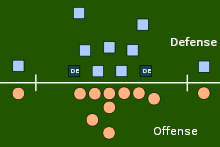- Defensive end
-
Defensive end (DE) is the name of a defensive position in the sport of American and Canadian football.
This position has designated the players at each end of the defensive line, but changes in formations have substantially changed how the position is played over the years. Eleven-time pro bowler and National Football League Hall of Famer Bruce Smith, usually considered one of the best defensive ends ever, is the all-time leader in career sacks with 200.
History
Early formations, with six- and seven-man lines, used the end as a containment player, whose job was first to prevent an "end run" around his position, then secondarily to force plays inside.
When most teams adopted a five-man line, two different styles of end play developed: "crashing" ends, who rushed into the backfield to disrupt plays, and "stand-up" or "waiting" ends, who played the more traditional containment style. Some teams would use both styles of end play, depending on game situations.
Traditionally, defensive ends are in a three-point stance, with their free hand cocked back ready to "punch" the offensive lineman, or in a "two-point stance" like a linebacker so they can keep containment. Some defensive ends play the position due to their size; they close down their gap so the running back has no hole to run through. Other ends play the position due to their speed and agility; they are used to rush the quarterback. These ends can time the snap of the ball in order to get a jump on the rush.
Most of the time it is the job of the defensive end to keep outside or contain, which means that no one should get to their outside; they must keep everything to the inside. The defensive ends are fast for players of their size, often the fastest and smallest players on the defensive line. They must be able to shed blockers to get to the ball. Defensive ends are also often used to cover the outside area of the line of scrimmage, to tackle ball carriers running to the far right or left side, and to defend against screen passes. Since the creation of zone blitz defenses in the late 1990s, defensive ends have sometimes been used in pass coverages, dropping back to cover routes run close to the line of scrimmage.
In the 3-4 defense, defensive ends are used primarily as run stoppers and are much larger. Often, the position is played by a more agile or slightly undersized defensive tackle. Because of the increased popularity of the 3-4 defense, the value of a defensive tackle prospect that can possibly be used in this manner has increased.
References
See also
Positions in American football and Canadian football Offense Defense Special teams Linemen Guard, Tackle, Center Linemen Tackle, End, Nose tackle Kicking players Placekicker, Punter, Kickoff specialist Quarterback Linebackers Snapping Long snapper, Holder Backs Halfback (Tailback), Fullback, H-back Backs Cornerback, Safety Returning Punt returner, Kick returner Receivers Wide receiver, Tight end, Slotback Nickelback, Dimeback Tackling Gunner Formations – Nomenclature Gridiron football concepts Codes American • Canadian (US–Canadian comparison) • Arena • Indoor • 9-man • 8-man • 6-man • Flag • Touch • Street/BackyardLevels of play Field End zone • Goal line • Line of scrimmage • Neutral zone • Field goal range • Out of bounds • SidelinesEquipment Positions Offense: Quarterback • Running backs (Halfback, Fullback, H-back) • Receivers (Wide receiver, Tight end, Slotback) • Linemen (Center, Guard, Tackle)
Defense: Linemen (Defensive tackle, Defensive end, Nose tackle) • Linebacker • Defensive back (Cornerback, Safety, Nickelback, Dimeback, Halfback)
Special Teams: Placekicker • Punter • Kickoff specialist • Long snapper • Holder • Punt returner • Kickoff returner • Return specialist • Gunner
Other: Utility player • Triple-threat man • Skill positionPlay types Offense: Rush • Pass • Incomplete pass • Lateral • Bootleg play • Draw play • End-around • Flea flicker • Flexbone formation • Fourth down conversion • Hail Mary pass • Halfback option play • Hook and lateral • Kneel • Motion • Hurry-up offense • Option run • Option offense • Play-action pass • Quarterback keeper • Quarterback sneak • Quick kick • Reverse • Scramble • Screen pass • Spike • Statue of Liberty • Sweep • Trick play • Wildcat formation
Defense: Tackle • Blitz • Rush • Sack • Shooting the gap • Stunt • Zone blitz
Special Teams: Kickoff • Kickoff return • Punt • Punt return • Drop kick • Fair catch • Fair catch kick • Icing the kicker • Onside kick • Squib kick • TryScoring Penalties Blocking below the waist • Block in the back • Chop block • Clipping • Delay of game • Encroachment • Equipment violations • Face mask • False start • Horse-collar tackle • Illegal contact • Illegal formation • Illegal forward kick • Illegal forward pass • Illegal hands to the face • Illegal motion • Illegal participation • Illegal shift • Illegal substitution • Illegal touching • Illegal touching of a free kick • Illegal use of hands • Ineligible receiver downfield • Intentional grounding • Holding • Leaping • Neutral Zone Infraction • Offside • Palpably unfair act • Pass interference • Personal Foul • Roughing the kicker • Roughing the passer • Roughing the snapper • Sideline infraction • Spearing • Time count • Tripping • Unsportsmanlike conductTurnovers Downs Play clock Statistics Passer rating • Reception • Receiving yards • Return yards • Total offense • Yards from scrimmage • All-purpose yardage • Touchdown passCelebrations Miscellaneous Snap • Dead ball • Touchback • Instant replay • Coffin corner • Glossary of American football • Glossary of Canadian football • Rules • Rules in American footballCategories:
Wikimedia Foundation. 2010.

